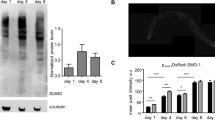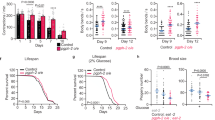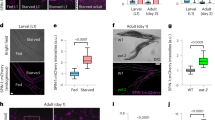Abstract
Marked alterations in cellular energy metabolism are a universal hallmark of the ageing process1. The biogenesis and function of mitochondria, the energy-generating organelles in eukaryotic cells, are primary longevity determinants. Genetic or pharmacological manipulations of mitochondrial activity profoundly affect the lifespan of diverse organisms2. However, the molecular mechanisms regulating mitochondrial biogenesis and energy metabolism during ageing are poorly understood. Prohibitins are ubiquitous, evolutionarily conserved proteins, which form a ring-like, high-molecular-mass complex at the inner membrane of mitochondria3. Here, we show that the mitochondrial prohibitin complex promotes longevity by modulating mitochondrial function and fat metabolism in the nematode Caenorhabditis elegans. We found that prohibitin deficiency shortens the lifespan of otherwise wild-type animals. Notably, knockdown of prohibitin promotes longevity in diapause mutants or under conditions of dietary restriction. In addition, prohibitin deficiency extends the lifespan of animals with compromised mitochondrial function or fat metabolism. Depletion of prohibitin influences ATP levels, animal fat content and mitochondrial proliferation in a genetic-background- and age-specific manner. Together, these findings reveal a novel mechanism regulating mitochondrial biogenesis and function, with opposing effects on energy metabolism, fat utilization and ageing in C. elegans. Prohibitin may have a similar key role in modulating energy metabolism during ageing in mammals.
This is a preview of subscription content, access via your institution
Access options
Subscribe to this journal
Receive 51 print issues and online access
$199.00 per year
only $3.90 per issue
Buy this article
- Purchase on Springer Link
- Instant access to full article PDF
Prices may be subject to local taxes which are calculated during checkout




Similar content being viewed by others
References
Roberts, S. B. & Rosenberg, I. Nutrition and aging: changes in the regulation of energy metabolism with aging. Physiol. Rev. 86, 651–667 (2006)
Balaban, R. S., Nemoto, S. & Finkel, T. Mitochondria, oxidants, and aging. Cell 120, 483–495 (2005)
Back, J. W. et al. A structure for the yeast prohibitin complex: structure prediction and evidence from chemical crosslinking and mass spectrometry. Protein Sci. 11, 2471–2478 (2002)
Nijtmans, L. G. et al. Prohibitins act as a membrane-bound chaperone for the stabilization of mitochondrial proteins. EMBO J. 19, 2444–2451 (2000)
Mishra, S., Murphy, L. C., Nyomba, B. L. & Murphy, L. J. Prohibitin: a potential target for new therapeutics. Trends Mol. Med. 11, 192–197 (2005)
Artal-Sanz, M. et al. The mitochondrial prohibitin complex is essential for embryonic viability and germline function in Caenorhabditis elegans . J. Biol. Chem. 278, 32091–32099 (2003)
Kimura, K. D., Tissenbaum, H. A., Liu, Y. & Ruvkun, G. daf-2, an insulin receptor-like gene that regulates longevity and diapause in Caenorhabditis elegans . Science 277, 942–946 (1997)
Kenyon, C. The plasticity of aging: insights from long-lived mutants. Cell 120, 449–460 (2005)
Shaw, W. M. et al. The C. elegans TGF-β dauer pathway regulates longevity via insulin signaling. Curr. Biol. 17, 1635–1645 (2007)
Estevez, M. et al. The daf-4 gene encodes a bone morphogenetic protein receptor controlling C. elegans dauer larva development. Nature 365, 644–649 (1993)
Ren, P. et al. Control of C. elegans larval development by neuronal expression of a TGF-β homolog. Science 274, 1389–1391 (1996)
Li, W., Kennedy, S. G. & Ruvkun, G. daf-28 encodes a C. elegans insulin superfamily member that is regulated by environmental cues and acts in the DAF-2 signaling pathway. Genes Dev. 17, 844–858 (2003)
Van Gilst, M. R., Hadjivassiliou, H., Jolly, A. & Yamamoto, K. R. Nuclear hormone receptor NHR-49 controls fat consumption and fatty acid composition in C. elegans . PLoS Biol. 3, e53 (2005)
Francis, R., Barton, M. K., Kimble, J. & Schedl, T. gld-1, a tumor suppressor gene required for oocyte development in Caenorhabditis elegans . Genetics 139, 579–606 (1995)
Coates, P. J., Jamieson, D. J., Smart, K., Prescott, A. R. & Hall, P. A. The prohibitin family of mitochondrial proteins regulate replicative lifespan. Curr. Biol. 7, 607–610 (1997)
Coates, P. J. et al. Mammalian prohibitin proteins respond to mitochondrial stress and decrease during cellular senescence. Exp. Cell Res. 265, 262–273 (2001)
Gershman, B. et al. High-resolution dynamics of the transcriptional response to nutrition in Drosophila: a key role for dFOXO. Physiol. Genom. 29, 24–34 (2007)
Nakae, J. et al. Forkhead transcription factor FoxO1 in adipose tissues regulates energy storage and expenditure. Diabetes 57, 563–576 (2008)
Rea, S. & Johnson, T. E. A metabolic model for life span determination in Caenorhabditis elegans . Dev. Cell 5, 197–203 (2003)
Schulz, T. J. et al. Glucose restriction extends Caenorhabditis elegans life span by inducing mitochondrial respiration and increasing oxidative stress. Cell Metab. 6, 280–293 (2007)
Apfeld, J., O'Connor, G., McDonagh, T., DiStefano, P. S. & Curtis, R. The AMP-activated protein kinase AAK-2 links energy levels and insulin-like signals to lifespan in C. elegans . Genes Dev. 18, 3004–3009 (2004)
Jones, R. G. et al. AMP-activated protein kinase induces a p53-dependent metabolic checkpoint. Mol. Cell 18, 283–293 (2005)
Oh, S. W. et al. JNK regulates lifespan in Caenorhabditis elegans by modulating nuclear translocation of forkhead transcription factor/DAF-16. Proc. Natl Acad. Sci. USA 102, 4494–4499 (2005)
Paradis, S. & Ruvkun, G. Caenorhabditis elegans Akt/PKB transduces insulin receptor-like signals from AGE-1 PI3 kinase to the DAF-16 transcription factor. Genes Dev. 12, 2488–2498 (1998)
Merkwirth, C. et al. Prohibitins control cell proliferation and apoptosis by regulating OPA1-dependent cristae morphogenesis in mitochondria. Genes Dev. 22, 476–488 (2008)
Olichon, A. et al. Loss of OPA1 perturbates the mitochondrial inner membrane structure and integrity, leading to cytochrome c release and apoptosis. J. Biol. Chem. 278, 7743–7746 (2003)
Schleicher, M. et al. Prohibitin-1 maintains the angiogenic capacity of endothelial cells by regulating mitochondrial function and senescence. J. Cell Biol. 180, 101–112 (2008)
Tatsuta, T., Model, K. & Langer, T. Formation of membrane-bound ring complexes by prohibitins in mitochondria. Mol. Biol. Cell 16, 248–259 (2005)
Ashrafi, K. et al. Genome-wide RNAi analysis of Caenorhabditis elegans fat regulatory genes. Nature 421, 268–272 (2003)
Soukas, A. A., Kane, E. A., Carr, C. E., Melo, J. A. & Ruvkun, G. Rictor/TORC2 regulates fat metabolism, feeding, growth, and life span in Caenorhabditis elegans . Genes Dev. 23, 496–511 (2009)
Kampkötter, A. et al. Effects of the flavonoids kaempferol and fisetin on thermotolerance, oxidative stress and FoxO transcription factor DAF-16 in the model organism Caenorhabditis elegans . Arch. Toxicol. 81, 849–858 (2007)
Cristina, D., Cary, M., Lunceford, A., Clarke, C. & Kenyon, C. A regulated response to impaired respiration slows behavioral rates and increases lifespan in Caenorhabditis elegans . PLoS Genet. 5, e1000450 (2009)
Braeckman, B. P., Houthoofd, K., De Vreese, A. & Vanfleteren, J. R. Assaying metabolic activity in ageing Caenorhabditis elegans . Mech. Ageing Dev. 123, 105–119 (2002)
Gášková, D., DeCorby, A. & Lemire, B. D. DiS-C3(3) monitoring of in vivo mitochondrial membrane potential in C. elegans . Biochem. Biophys. Res. Commun. 354, 814–819 (2007)
Acknowledgements
We thank A. Pasparaki for technical support with experiments. Some nematode strains used in this work were provided by the C. elegans Gene Knockout Project at OMRF (http://www.mutantfactory.ouhsc.edu/), which is part of the International C. elegans Gene Knockout Consortium, the Caenorhabditis Genetics Center, which is funded by the NIH National Center for Research Resources (NCRR), and S. Mitani (National Bioresource Project) in Japan. We thank A. Fire for plasmid vectors and J. Berden for antibodies. This work was funded by grants from EMBO, the European Research Council (ERC), the Marie Curie Fellowships Programme and the European Commission Coordination Action ENINET (contract number LSHM-CT-2005-19063).
Author Contributions M.A.-S. and N.T. designed and performed experiments, analysed data and wrote the manuscript.
Author information
Authors and Affiliations
Corresponding authors
Supplementary information
Supplementary Information
This file contains Supplementary Table I, Supplementary Figures S1-S15 with Legends and Supplementary References. (PDF 4896 kb)
Rights and permissions
About this article
Cite this article
Artal-Sanz, M., Tavernarakis, N. Prohibitin couples diapause signalling to mitochondrial metabolism during ageing in C. elegans. Nature 461, 793–797 (2009). https://doi.org/10.1038/nature08466
Received:
Accepted:
Issue Date:
DOI: https://doi.org/10.1038/nature08466
This article is cited by
-
Mitochondria-derived peptide MOTS-c: effects and mechanisms related to stress, metabolism and aging
Journal of Translational Medicine (2023)
-
Acute social jetlag augments morning blood pressure surge: a randomized crossover trial
Hypertension Research (2023)
-
Lifespan-extending interventions induce consistent patterns of fatty acid oxidation in mouse livers
Communications Biology (2023)
-
Prohibitin Protein Expression During Spermatogenesis in the Large Yellow Croaker, Larimichthys crocea
Journal of Ocean University of China (2022)
-
Fluorizoline-induced apoptosis requires prohibitins in nematodes and human cells
Apoptosis (2021)
Comments
By submitting a comment you agree to abide by our Terms and Community Guidelines. If you find something abusive or that does not comply with our terms or guidelines please flag it as inappropriate.



